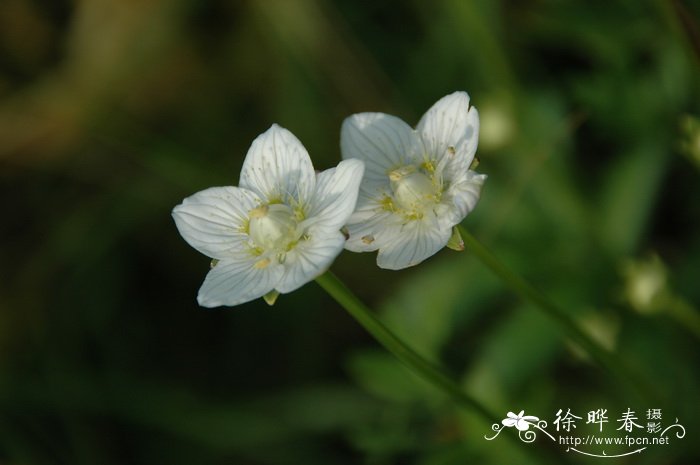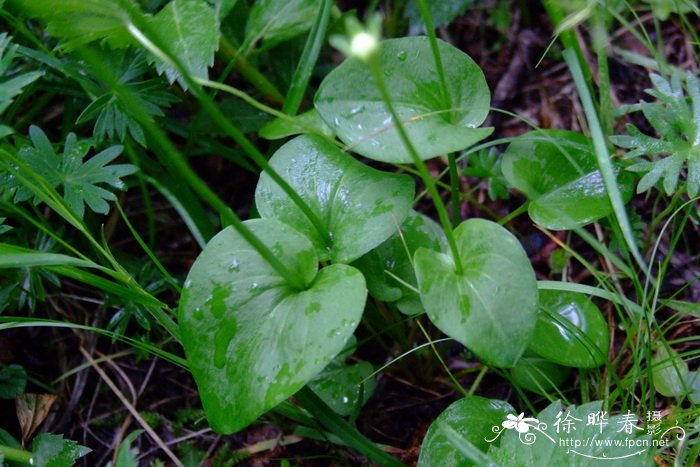多枝梅花草Parnassia palustris var. multiseta
中文名(Chinese Name):多枝梅花草
学名(Scientific Name):Parnassia palustris var. multiseta Ledeb.
英文名(English Common Name):
别名(Chinese Common Name):
异名(Synonym):Parnassia multiseta (Ledeb.) Fernald
科属(Family & Genus):虎耳草科(Saxifragaceae)梅花草属
形态特征(Description):本变种和原变种主要区别为退化雄蕊分枝多,(11-) 13-23条,比雄蕊长,比花瓣稍短;花期植株较高大,基生叶缺如或少而小。花期8月。
分布(Distribution):产黑龙江、吉林、辽宁、内蒙古、河北、山西及陕甘,生于海拔1250-2220米山坡和山沟阴处、河边以及草原和路边等处。朝鲜、日本及俄罗斯也有分布。
用途(Use):
引自中国植物志英文版:FOC Vol. 8 Page 379
Parnassia palustris var. multiseta Ledebour, Fl. Ross. 1: 263. 1842.
多枝梅花草 duo zhi mei hua cao| Saxifragaceae | Parnassia
Parnassia multiseta (Ledebour) Fernald.
Staminodes 13-21-branched.
Shaded places in valleys, streamsides, grassy fields; 1200-2200 m. Hebei, Heilongjiang, Jilin, Liaoning, Nei Mongol, Ningxia, Shanxi [Japan, Korea, Russia].
Losina-Losinskaja (in Komarov, Fl. URSS 9: 217. 1939) divided Parnassia palustris into four forms. However, after examining a large number of Chinese specimens of this species, the present authors have found that P. palustris is highly variable in many morphological characters, e.g., height of stem, number, shape, and size of basal leaves, position, shape, and size of cauline leaf, punctate marking, shape, and venation of sepals and petals, and number and length of staminode branches. It is not possible to classify Losina-Losinskaja's forms according to these characters. On the other hand, the the present authors accept the two varieties of P. palustris described by Ledebour (Fl. Ross. 1: 262. 1842) based on the number of staminode branches. In the present account, according to Ledebour's delimitation, the population in Xinjiang is identified as var. palustris and the populations in N and NE China as var. multiseta.



(责任编辑:徐晔春)
学名(Scientific Name):Parnassia palustris var. multiseta Ledeb.
英文名(English Common Name):
别名(Chinese Common Name):
异名(Synonym):Parnassia multiseta (Ledeb.) Fernald
科属(Family & Genus):虎耳草科(Saxifragaceae)梅花草属
形态特征(Description):本变种和原变种主要区别为退化雄蕊分枝多,(11-) 13-23条,比雄蕊长,比花瓣稍短;花期植株较高大,基生叶缺如或少而小。花期8月。
分布(Distribution):产黑龙江、吉林、辽宁、内蒙古、河北、山西及陕甘,生于海拔1250-2220米山坡和山沟阴处、河边以及草原和路边等处。朝鲜、日本及俄罗斯也有分布。
用途(Use):
引自中国植物志英文版:FOC Vol. 8 Page 379
Parnassia palustris var. multiseta Ledebour, Fl. Ross. 1: 263. 1842.
多枝梅花草 duo zhi mei hua cao| Saxifragaceae | Parnassia
Parnassia multiseta (Ledebour) Fernald.
Staminodes 13-21-branched.
Shaded places in valleys, streamsides, grassy fields; 1200-2200 m. Hebei, Heilongjiang, Jilin, Liaoning, Nei Mongol, Ningxia, Shanxi [Japan, Korea, Russia].
Losina-Losinskaja (in Komarov, Fl. URSS 9: 217. 1939) divided Parnassia palustris into four forms. However, after examining a large number of Chinese specimens of this species, the present authors have found that P. palustris is highly variable in many morphological characters, e.g., height of stem, number, shape, and size of basal leaves, position, shape, and size of cauline leaf, punctate marking, shape, and venation of sepals and petals, and number and length of staminode branches. It is not possible to classify Losina-Losinskaja's forms according to these characters. On the other hand, the the present authors accept the two varieties of P. palustris described by Ledebour (Fl. Ross. 1: 262. 1842) based on the number of staminode branches. In the present account, according to Ledebour's delimitation, the population in Xinjiang is identified as var. palustris and the populations in N and NE China as var. multiseta.
(责任编辑:徐晔春)
踩一下[0]

顶一下[2]